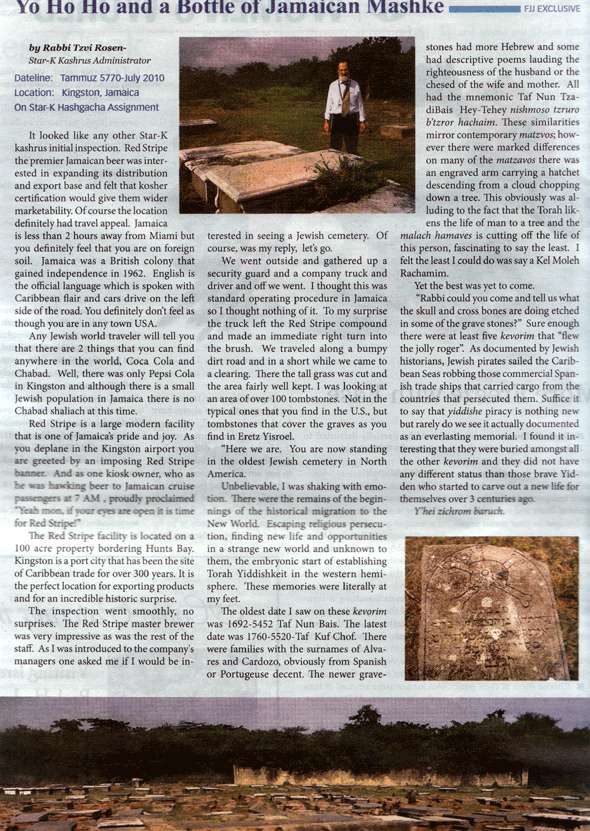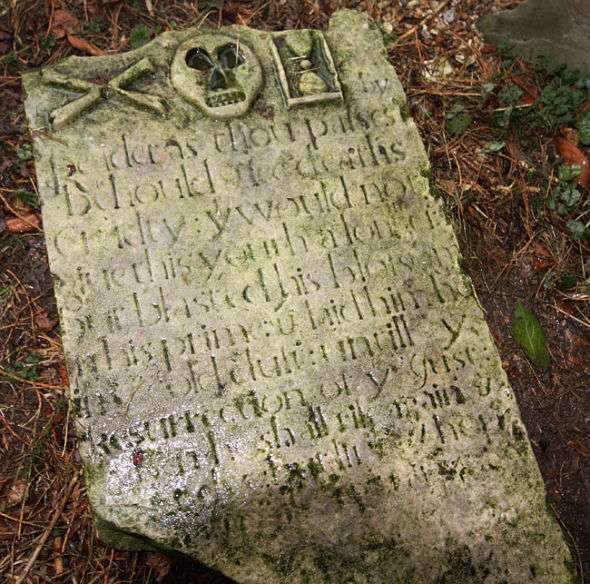
The author was taken to visit a very old Jewish cemetery (by North American standards - a 300 year old Jewish cemetery is not old in the Old World). As you can see, he was charmed and impressed by five Jewish graves that seem to have the fabled Jolly Roger symbol of piracy (skull and crossbones). Note that his tour guide did not tell him that is what those symbols meant - not that it would matter too much if they did. Rather, he was asked by them "Rabbi could you come and tell us what the skull and cross bones are doing etched in some of the grave stones?"

Detail:

Knowing (or sort of remembering?) that Jewish buccaneers have been "documented by Jewish historians," he assumed as most people would that these were graves of Jewish pirates. See here for example. It's the same grave. Of course it is "interesting that they were buried amongst all the other kevorim and they did not have any different status than those brave Yidden who started to carve out a new life for themselves over 3 centuries ago." I know that pirates are positively charming. I mean, who doesn't love pirates? They had parrots? They said "yaaarr." Still I'm not a huge fan of marauding and murder, so I was thinking that perhaps no evidence was shown that these graves are the graves of pirates. Thus, we also don't have to ask why the Jews buried them in regular graves in the cemetery, as opposed to treating them like criminals - to the extent that they'd even etch the symbols of their trade onto their matzevah (grave stone), stamped with the wish that their souls be bound in the bonds of eternal life - תנצבה?
Although at first glance it seems like a reasonable assumption, this is because the skull and bones survive to the present consciousness only as symbols of piracy. However, actually they were symbols of death, and in the period in question they were often carved on tombstones of fine, upstanding people. The practice is Memento Mori, or a reminder of mortality. It's like wearing a kittel on Yom Kippur.
There are many examples which you can find quite easily. For example, this blog has a beautiful and haunting picture of the following grave of one Ellis Penson, deceased at age 23 in 1720:

Since it's hard to read, here is the transcript posted at that blog:
Reader as thou passes by
Behould thee death’s
Cruelty: yt would not
give this youth a longer time
but blasted his blossom
in his prime: it hid him here
in mold duli: untill ye
resurrection of ye Just
then he shall rise again
etc
He certainly was no pirate. I should also take the opportunity to note that "ye" (often mangled in quaint stores with names like "Ye Olde Something-or-other Shoppe") is the word "the." It is not a Y, but a symbol that is an abbrevation for "th," derived from the third letter of the Saxon alphabet, thorn with a superscript e: þe.
 See here.
See here.Years ago I posted a picture of Judah Monis's grave at English Hebraica:

In a post in 2009 called They don't make Hevra Kadishah guidebooks like they used to I made the obvious joke: pirates of the kadishah.

Amsterdam, 1810 - link.
In short, without ANY evidence that these graves are Jewish pirates I would say they were not Jewish pirates. I think the stone is as cool as he does though.

